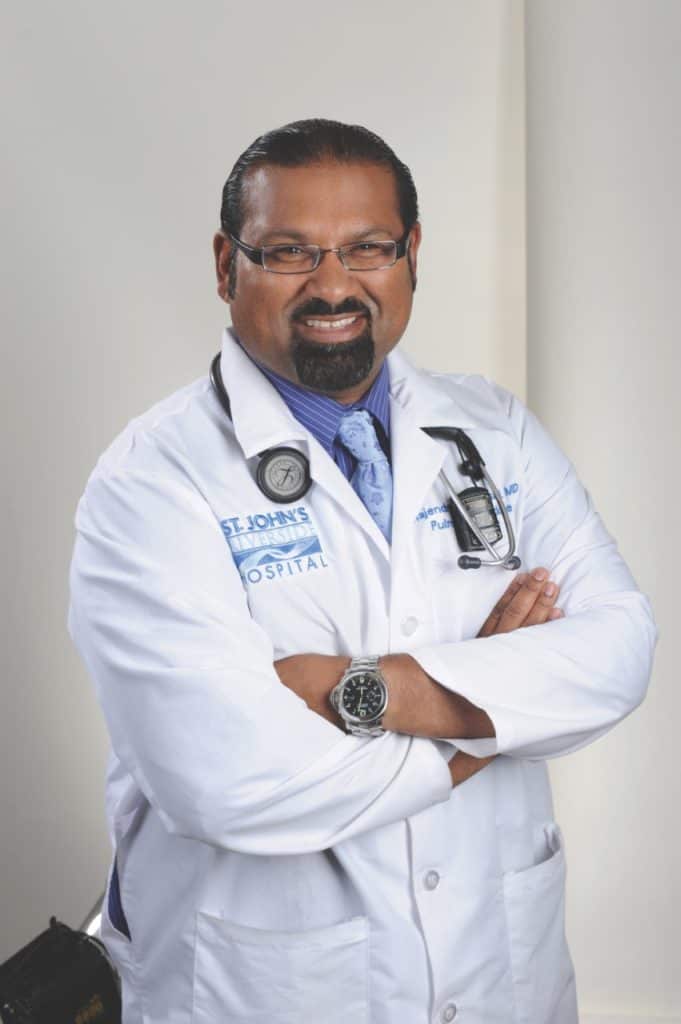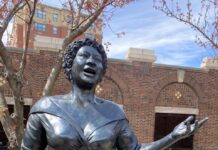
By Dan Murphy
More than 100 million Americans suffer some form of sleep trouble, and F. Scott Fitzgerald said it best, “The worst thing in the world is to try to sleep and not to.”
Most adults need seven or more hours of quality sleep each night to get up and have a productive day. But how do we get those quality hours of sleep on a consistent basis? And for those of us who do having trouble sleeping most nights, is there a reason, or a medical diagnosis that can help us achieve a good night’s sleep?
We recently spoke to Dr. Rajendra Rampersaud, who leads St John’s Riverside Hospital’s Sleep Diagnostic Center, about sleep disorders. “I got interested in studying about sleep when I started working the night shift, from 7pm-7am. I developed sleep issues based on my rotating schedule, so I started studying it for myself.”
“There are dozens of medical sleep disorders. At the top of the list is insomnia. In the USA 100 million Americans report poor sleep and many are using sleeping aids. It has reached epidemic levels, and it’s important to know the difference between a bad night’s sleep, which we all may have, or a sleep disorder.”
Dr. Rampersaud explained that Sleep Apnea is a sleep disorder that most of us have heard of and one that can be treated. “Sleep Apnea is a condition that we can test for, diagnose, and treat. Sleep Apnea occurs when there is a cessation or blockage of air flow while you are sleeping,”
“We have evidenced based data that untreated Sleep Apnea can potentially lead to other common medical issues, such as diabetes, high cholesterol, and hypertension. Some common signs and symptoms for Sleep Apnea are snoring, pauses in breathing, excessive daytime sleepiness, or if you have a neck size of 17 inches or more for men, (16 inches for women) then you are at risk.”
Sleep Apnea occurs in about 3 percent of normal weight individuals but affects over 20 percent of obese people. Sleep Apnea affects men more than women; however, Sleep Apnea rates increase sharply in women after menopause. Age and ethnicity can also play a role in tendencies for Sleep Apnea.
Dr. Rampersaud said that “Almost 85% of people who have Sleep Apnea stay undiagnosed. We screen patients at the sleep center at St. John’s, and we can conduct a sleep study for most individuals, adults or kids.”
Circadian cycle disorders, also known as sleep-wake cycle disorders, are problems that occur when your body’s internal clock, which tells you when it is time to sleep or wake, is out-of-sync with your environment. This is common in people who work at night or who have varying work or personal schedules which makes their sleep times vary. “Jet lag, or shift work disorder schedules, can lead to circadian rhythm problems. It is a big burden when you cannot get a good night’s sleep while the rest of us are sleeping.”
Nacolepsy is another sleep disorder that some may have heard of. “This is a chronic sleep disorder characterized by significant daytime sleepiness and sudden attacks of sleep,” said Dr. Rampersaud, who added that less than 3% of Americans who have a sleep disorder have Nacolepsy.
But what about most of the 100 million Americans who don’t have Sleep Apnea, or Narcolepsy, or a strange work or life schedule that makes them change their sleeping habits? What about the average person who just cannot get to sleep at night?
Dr. Rampersaud gave our readers factors, thoughts, and tips on helping with your sleep disorder. “If you are overweight and over the age of fifty, this leads to a risk of sleep troubles. 20% of men over 50 and 10% of women over 50-are at risk. Our elderly population has a higher rate of a disorder called Advanced Sleep Phase Disorder in which they tend to eat dinner early and go to bed early.
But people of all ages can have trouble with their sleep. A common condition in adolescents and teenagers is Delayed Sleep Phase Disorder in which the go to sleep later and later into the night. These are symptoms that are related to a sleep disorder that people may not easily identify or make a connection to.
The American Academy of Sleep reports 7 hours of good sleep is optimal. Beyond 9 hours is usually excessive. Much less can lead to medical issues, the most obvious being chronic fatigue. Most patients who have a sleep disorder have sleepiness or fatigue in the afternoon.”
Most of us have heard of REM (Rapid Eye Movement) Sleep. Dr. Rampersaud explained the vital nature of REM sleep. “It is estimated that 90% of our dreams occur in REM sleep. About every two hours we cycle through stages 1,2 3, and the REM. The second half of the sleep period is when we get most of our REM sleep, which is important for good sleep health. Deficiencies in REM sleep can lead to cognition and memory issues. In addition, common medications can prevent us from getting the proper REM sleep we need.”
Dr Rampersaud explains that “Sleep efficiency is the ratio of the time we are asleep divided by the time spent in bed. What is considered normal is about 80%. Sleep can be manipulated by timing and maintaining consistent sleep and rise times, this is part of what is called Sleep Hygiene. Each of us has an inherent circadian cycle that can be optimized by good sleep habits.”
Stress, no eating or caffeine before sleep, and lighting, all play a role in getting a good night’s sleep, according to Dr. Rampersaud. “The most common Insomnia is related to Psychophysiological issues of stress and not being able to shut down our thoughts at night. We worry and look at the clock. We try to teach people to reduce their sympathetic tone and put away their stressful thoughts. Do not start reading the book you have been waiting to read or overstimulate your mind right before you go to bed.
Try not to eat or have caffeine or nicotine 4-6 hours before you go to bed. This is part of the process of preparing for sleep. Preparing your bedroom to be dark, inviting, and a cool temperature, will also help. Also try breathing exercises to reduce your heart rate. If you are in bed for more than 30 minutes and cannot get to sleep, get out of bed, and do something mundane to bridge your time until you feel sleepy. Do not stay in bed if you cannot sleep. A simple way to build up a sleep drive is to get yourself tired early in the day or in the hours before you go to sleep. “
In general, Dr. Rampersaud is not a fan of sleeping aids (both prescribed or over the counter) as their effectiveness diminishes over time and there is a potential for unwanted effects. “I see patients who have taken any one of these ‘Z’ drugs for years at a time. Receptors in our brain get desensitized to these medications and over the course of time have a dwindling affect.”
If you are unsure about what your sleep trouble may be, the best way to get an answer is to visit Dr. Rampersaud at St John’s Riverside Hospital Sleep Center Diagnostic Center. An overnight stay in a comfortable room is all it takes for technicians to monitor your heart, brainwaves, and airflow. Throughout the night a dedicated technician will be present to monitor the study while you sleep comfortably. Tests results will be promptly sent to your physician within 72 hours of the test.
Sleep Diagnostic Services are now available at the Andrus location. For more information or to schedule a consultation with a sleep physician call (914) 964-4337. To schedule a sleep study at the Sleep Diagnostic Center call (914) 559–1010.
Dr. Rampersaud is a Board-Certified Pulmonologist who holds an additional Board Certification in Sleep Medicine. He completed his Sleep Medicine fellowship at the Sleep Disorder Institute in New York. He is a member of the American Academy of Sleep Medicine.





